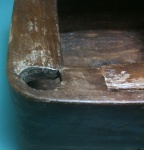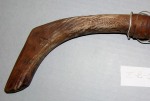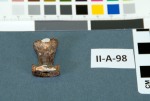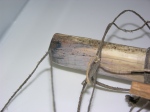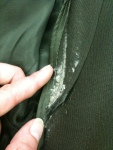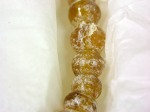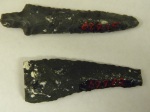Under Construction August 2011
1. BACKGROUND
Glass structure is composed primarily of silicates and can remain stable and relatively unchanged for hundreds, if not thousands, of years if cared for properly. Unfortunately, even with the proper care, this is not always the case as some glass is known to deteriorate rapidly over time.
On a chemical level, most glass is stable. However, some glass artifacts are known to undergo a complex disintegration. This chemical breakdown of glass is commonly known as glass disease. When discussed in reference to the most ubiquitous of archaeological and ethnographic artifacts, the glass bead, it is often termed ‘bead disease’.
The main component in glass is silicon dioxide, also known as silica. Silica occurs naturally in three forms. Its solid form is known as quartz, its amorphous or non-crystalline form is known as opal, and it is commonly found in its impure form as sand. Glass can be made from pure silica, but it has a very high melting point of 4,172 ° F – which makes it rather difficult to work with directly. For this reason, most glass mixtures have traditionally contained 70-74% silica and 16-22% of an alkali material, which serves to lower the glass melting point. Quite often, the alkali material used was either soda ash, a sodium carbonate which is obtained from burnt plant material, or potash, a potassium carbonate usually derived from wood ash.
The sodium carbonate in soda ash produces a clearer glass than potash, so it was – and still is – more commonly used in glass manufacture. However, when sodium carbonate is added to silica, the resulting glass is water soluble – meaning it will dissolve in water. This is generally an undesirable characteristic for glass. For that reason, lime (calcium oxide) is often added along with other minerals for better durability. The addition of lime also helps the different components to mix together more easily.
2. POSSIBLE CAUSES
The most common white stuff we have seen on Alaskan glass artifacts is glass disease (crizzling, weeping) on beads. Abrasion, ghosting, mold, and previous treatments have also been seen on glass.
Glass Disease
While glass disease is seen on various kinds of glass objects, the most common Alaskan artifacts we have seen it on are glass beads. This damage might be historically interesting, as it might suggest a very old bead.
By the 16th century in western Europe, the production of glass (and beads in particular) became central to the economic and political endeavors of the time. According to Lois Sherr Dubin, (2009, 29) “For Europeans, whose aim was to maintain maximum profits with a minimum commitment of manpower and resources, glass beads, exchanged for American furs or African ivory, gold, and slaves, yielded enormous margins – 1,000 percent was the return on investment, according to a report in 1632 – and thus became a central part of international trade patterns.”
For a long time Venice was the center of glass bead production in Europe. In 1292 A.D., glass production was moved from Venice to the nearby island of Murano in an effort to keep their production methods completely secret as well as to protect Venice from the risk of fires from the now constantly burning glass furnaces. Production continued to increase throughout the centuries and bead making techniques were adjusted to meet the increasing demand and to decrease production costs as much as possible. Chemical compounds that were added to glass mixtures to lower the glass melting point began to be added in even larger amounts. This reduced the amount of fuel needed to run the furnaces and sped up the process overall.
As mentioned above, most glass consists of approximately three-quarters silica with sodium carbonate added to lower the melting point and calcium oxide to stabilize the mixture. If this combination is kept in balance, the glass is likely to remain stable. However, when there is an imbalance in the proportion of these components, problems can arise. If there is an excess of alkali and too little lime (as was happening in Murano), the surface of the glass may begin to react with moisture in the air and start to break down. This is the major cause of glass disease.
Glass disease is therefore inherent in the chemical makeup of certain glasses. This is both good and bad news. The good news is that it can’t spread to other glass in your collection– it’s not contagious. The bad news is that if the chemical composition of the bead lends itself to glass disease, there is nothing that can be done to stop it from breaking down. The corrosive nature of glass disease causes a snowball effect of sorts on objects that succumb to it. Once the process begins, there is no known treatment that can reverse the effects or stop it from proceeding. The degradation can be slowed down considerably with cleaning and careful monitoring of the storage environment, but nothing will “cure” it, so to speak.
At the present time, it is not fully understood how this decomposition of glass proceeds on a molecular level. However, we do know that in all glass the sodium and potassium carbonates are hygroscopic. This means that they readily take up and retain moisture from the air. Once these salts become hydrated, they can leach out of the glass and form crusty deposits on the surface.
As the sodium and potassium ions are removed from the chemical structure they are replaced by hydrogen ions, which diffuse throughout the glass. This creates a hydrated silica network which is inherently weaker. As the deterioration of the glass progresses, the surface of the glass becomes increasingly alkaline. An alkaline substance is one the measures above 7 on the pH scale.
A bead with glass disease will show many symptoms, some of which can be seen easily and others that may require the use of a magnifying lens or microscope. There are five signs of glass disease which are commonly cited by conservators. These are: broken beads, sweating or weeping beads, white crusty deposits, crizzling, and damage to the backing material. Additionally, as glass begins to deteriorate, it will quite often have a dull, foggy appearance. This results from deposits left on the surface of the glass, as well as crizzling altering the reflectivity of the glass.
In certain environments, droplets of moisture may appear on the surface of a glass bead. This is known as sweating or weeping. This occurs when atmospheric moisture combines with the alkali material used in the manufacture of the glass and causes the hygroscopic alkali salts leech out. These salts migrate to the surface forming a soapy, sticky alkaline solution. This soapy residue forms abrasive and caustic by-products, which draws dust and dirt to the surface. This in turn attracts more moisture to the glass and facilitates the progression of the glass bead deterioration. Glass beads may have a white, fuzzy look to them as salts from these residues crystallize, as well as from the dust and dirt attracted to the soapy alkaline residue.
Unstable glass and high humidity can also result in the formation of crusty deposits on the surface of beads. As discussed earlier, alkaline products that migrate out of the beads turn into alkaline salts, which are left on the surface of the bead or adjacent material. This produces a hard alkaline coating which can give glass a white, dusty appearance.
As the deterioration of unstable glass progress, small fissures in the surface of the glass start to become visible. This is known as crizzling and it is characterized by a fine all-over cracking or fracturing of glass. This step in the degradation of the glass can also lead to flaking and pitting on the surface of the bead. Crizzling of the glass surface can cause transparent beads to look opaque and also contributes to the appearance of a whitish haze.
It is not known for sure whether or not glass disease occurs in some colors and/or sizes of beads more than others, but our experience through this survey of Alaskan beads is that it might.
Abrasion/scratches
The most common problem associated with caring for historic glass, including glass beads, is their fragility. Like all glass objects, glass beads can crack, break, or become easily scratched if they, or the objects to which they are attached, are not carefully handled. Abrasion and scratches interfere with the way light passes through the glass and can cause a whitish, opaque haze. Think of glass fishing floats, for example, which can appear hazy if they have been abraded by sand.
Ghosting or transferred images
The reason that transferred images are sometimes referred to as “ghosting” is because a replica of the image can usually be seen in the glass. These images and other blooms on paintings are sometimes attributed to mold due to the microenvironment that exists between a painting and it’s glazing (Williams 1988, 66). It seems rather unlikely, however, to have a mold that grew in such a specific pattern as to duplicate an image. When the white accretions making up transferred images were analyzed in the 1980s, they were discovered to be made primarily from ketones and sodium soaps (Williams 1988, 69). The overall hypothesis for this is that ketones volatilize from the paint, condense on the glass and then oxidize into carboxylic acids. These acids then react with sodium in the glass to form the sodium soaps that make up the images (Williams 1988, 70). This is a similar reaction to that found happening in glass beads – particularly those in contact with lipid-containing ethnographic materials. It’s worth noting that in many cases where an artwork came into contact with glass, no transfer image was formed. Rather, a halo of clear glass remained around the point of contact with the transfer image forming again beyond this halo (Williams 1988, 68). Williams describes the primary melting point of the transfer image material analyzed as being consistently at 69°-70° C (1988, 67). Since the transfer images are composed of organic compounds, they have poor solubility in water. To test this, take a small sample of the white stuff and place it on a glass slide or similar. Add a couple drops of water. If the compound does not appear to dissolve, this would rule out a soluble salt and may indicate the presence of insoluble organic compound.
mold
Mold is typically described as having a fuzzy, velvety, or sometimes slimy appearance. Mold needs organic material to feed on, so glass doesn’t commonly provide the necessary ingredients. Glass used to frame a photo at the Alaska State Museum once had branch-like mold on the inside of the glass, suggesting the gelatin of the photo might have provided enough nutrients for mold. Glass beads strung on sinew or cotton thread might also provide adequate nutrition and you might see mold growing out of and around the beads – especially if the threads/sinew have absorbed moisture and created high RH microenvironments inside of the beads. Additionally, dust and grime that accumulate on glass can provide the necessary materials to allow for mold growth. Mold was once seen on the glass touching the surface of a framed photograph at the Alaska State Museum. When viewed under a microscope, the vegetative part of mold (known as mycelium http://en.wikipedia.org/wiki/Mycelium) can be seen as thin, thread-like branching hyphae and is very distinctive from the crystalline structure of salts. Mold growth generally begins to occur on organic materials when the environment is at 70% relative humidity or higher. The Canadian Conservation Institute (CCI) gives the following useful chart for mold growth on their “10 Agents of Deterioration” website http://www.cci-icc.gc.ca/crc/articles/mcpm/chap10-eng.aspx:
Previous treatment
Different types of treatments may have been used in the past on glass beaded objects that could cause a white or hazy appearance. Adhesives may have been used to reattach beads, and these often can look cloudy and opaque as they age. Pesticide residues can create a whitish haze over the surface of materials, including beads. Pesticides were commonly applied during the early 20th century to collections containing natural history specimens and ethnographic artifacts made of organic materials such as leather, fur, and feathers.
3. REFERENCES
Mold hyphae, image by Bob Blaylock
http://en.wikipedia.org/wiki/File:20100815_1818_Mold.jpg
Carroll, Scott and Kelly McHugh. (1999) “Material Characterization of Glass Disease on Beaded Ethnographic Artifacts from the Collection of the National Museum of the American Indian.” Ethnographic beadwork: Aspects of Manufacture, Use and Conservation. Edited by Margot M. Wright. Conservation Centre, National Museums and Galleries on Merseyside on 22 July 1999
Ellen Carrlee’s notes: Most impacted beads fell into one of two categories: waxy/crusty beads that tested positive for triglyceride oils and powdery/crystalline beads that did not. Sometimes kaolin clays used to whiten leather show up as white powder on beads but are not harmful. Spot testing was also able to ID chlorides on beads throught to have contact with salt water.
Dubin, Lois Sherr (2009) The History of Beads from 100,000 to the Present. Harry N Abrams, Inc. New York.
Fenn, Julia. (1987) “Deterioration of Glass Trade Beads in Contact with Skin and Leather or Glass Beads in Soapy Bubble.” ICOM Committee for Conservation 8th Triennial Meeting, Working Group 3 Ethnographic Materials. Sydney Australia. Pp 195-197.
Jenkins, Michael R. “Glass Trade Beads in Alaska.” Alaska Journal 2.3 (1972), 31-119.
Crista Pack’s notes: Date for beads entering Alaska is unknown; however trade may have brought them into the region long before the first contact with non-indigenous explorers. Gives an insightful and thorough history of bead trading and the value of beads along the NW coast. Provides many images of different types of bead and objects beads were used in the manufacture of.
Lougheed, S. (1988) “Deteriorating Glass Beads on Ethnographic Objects: Symptoms and Conservation.” Symposium 86: The Care and Preservation of Ethnographic Materials Editors R. Barclay et al Ottawa, Canadian Conservation Institute. Pp. 109-113.
Ellen Carrlee’s notes: Controlling RH is the best solution for beads that exhibit early symptoms of glass dieases such as broken beads, sweating beads, crusts on bead or thread, crizzling, bleached spot below the bead on a textile, darkening of leather in contact with the bead. RH should be between 35% and 42% ought to control it. Below 30% crizzling may occur, and above 42% alkaline carbonates that leach to the surface become hygroscopic and accelerate the process.
Ordonez, Eugenia and John Twilley, John. (1998) “Clarifying the Haze: Efflorescence on Works of Art” WAAC Newsletter 20 (1) 1998 pp 12-17.
Pearson, C. (1987) “Deterioration of Ceramic, Glass and Stone” Conservation of Marine Archaeological Objects. Butterworths. London.
Sirois, P. Jane. (1999). “The Deterioration of Glass Trade Beads from Canadian Ethnographic and Textile Collections.” The Conservation of Glass and Ceramics: Research, Practice and Training. Norman H. Tennant editor. James & James. London. Pp. 84-95
Williams, R. Scott. (1989) “Blooms, Blushes, Transferred Images and Mouldy Surfaces: What Are These Distracting Accretions on Art Works?” In Proceedings of the 14th Annual IIC-CG Conference 1988. Edited by Johanna G. Wellheiser. Ottawa. Pp 65-84
4. EXAMPLES IN ALASKA














